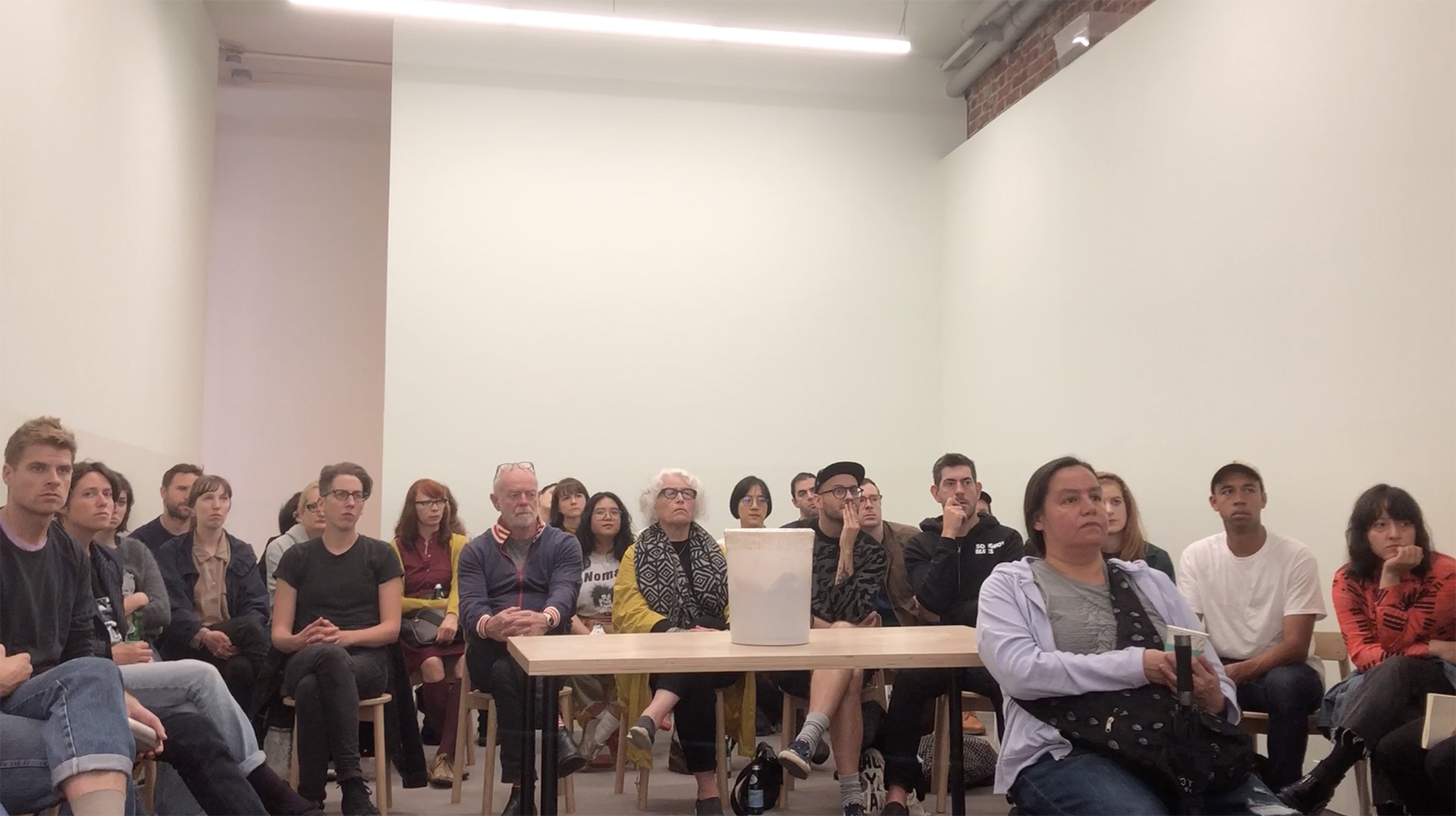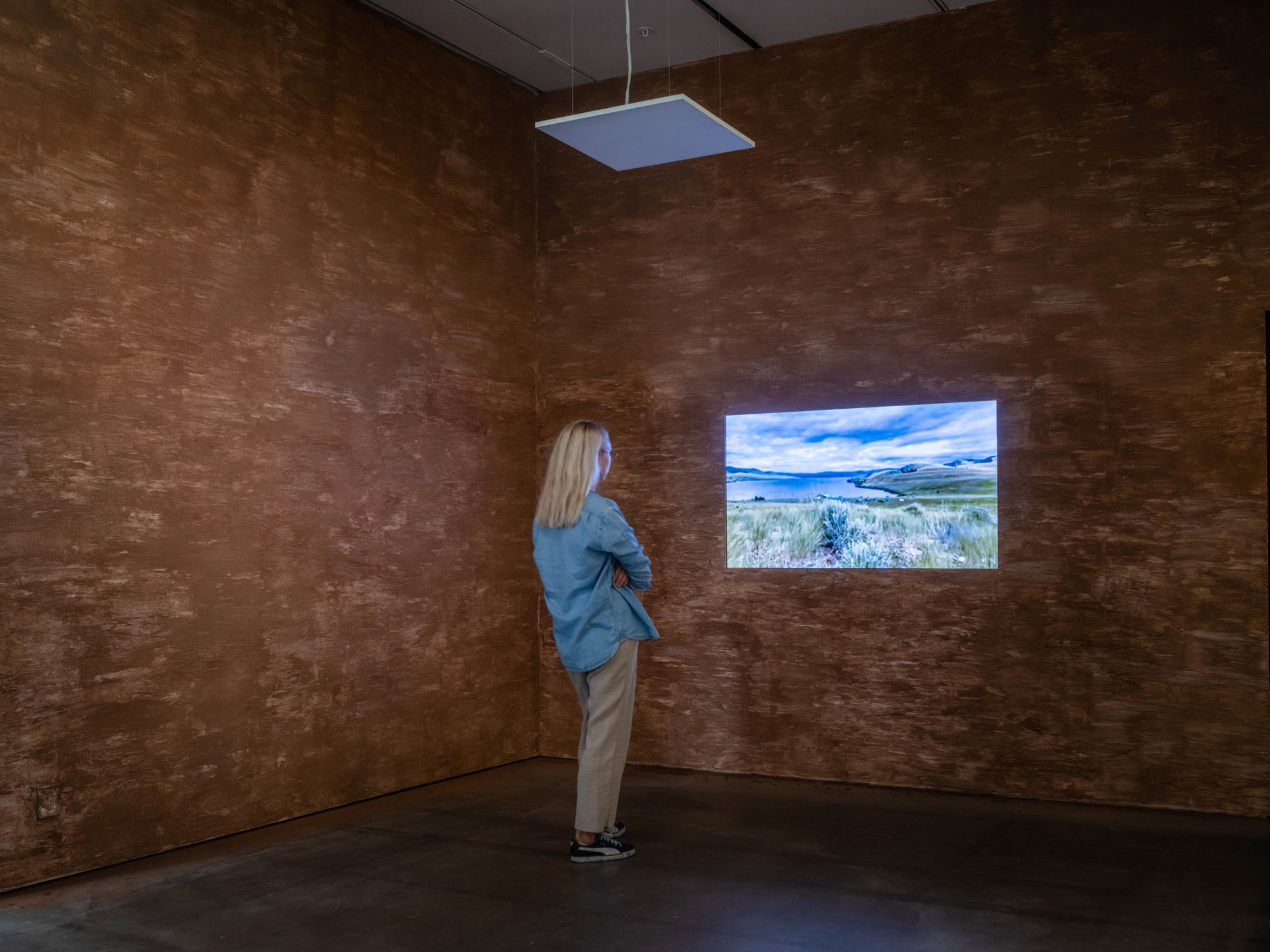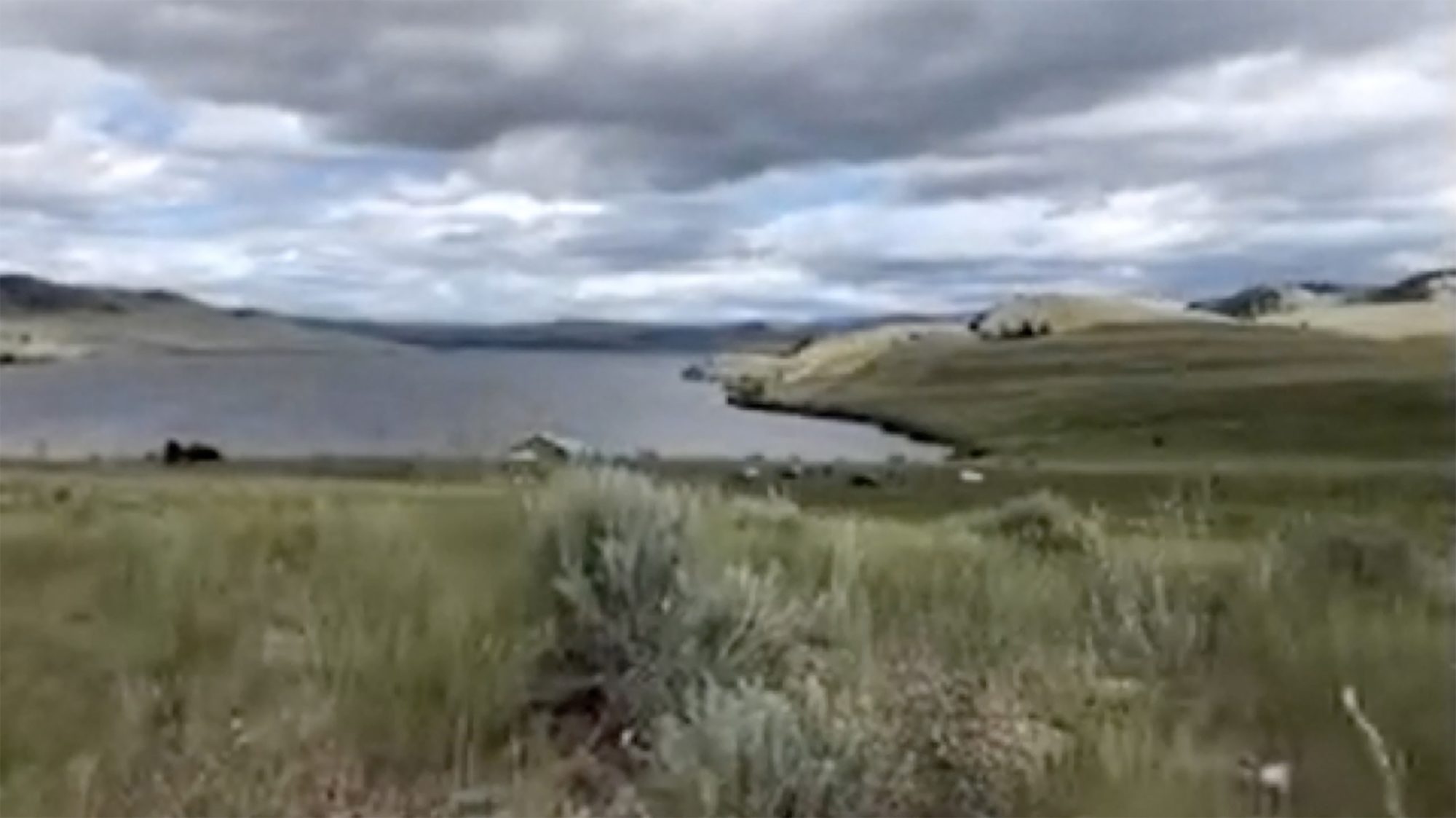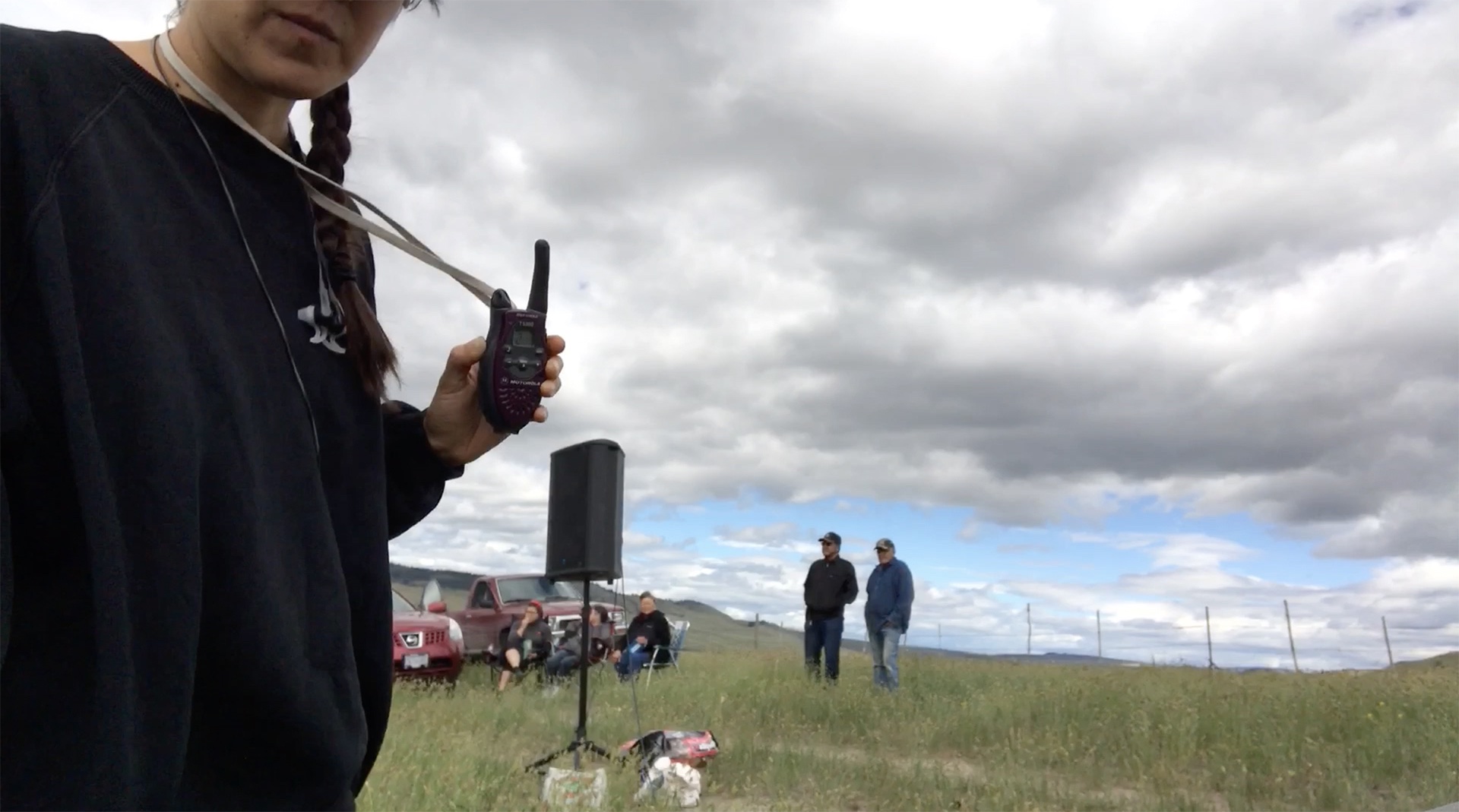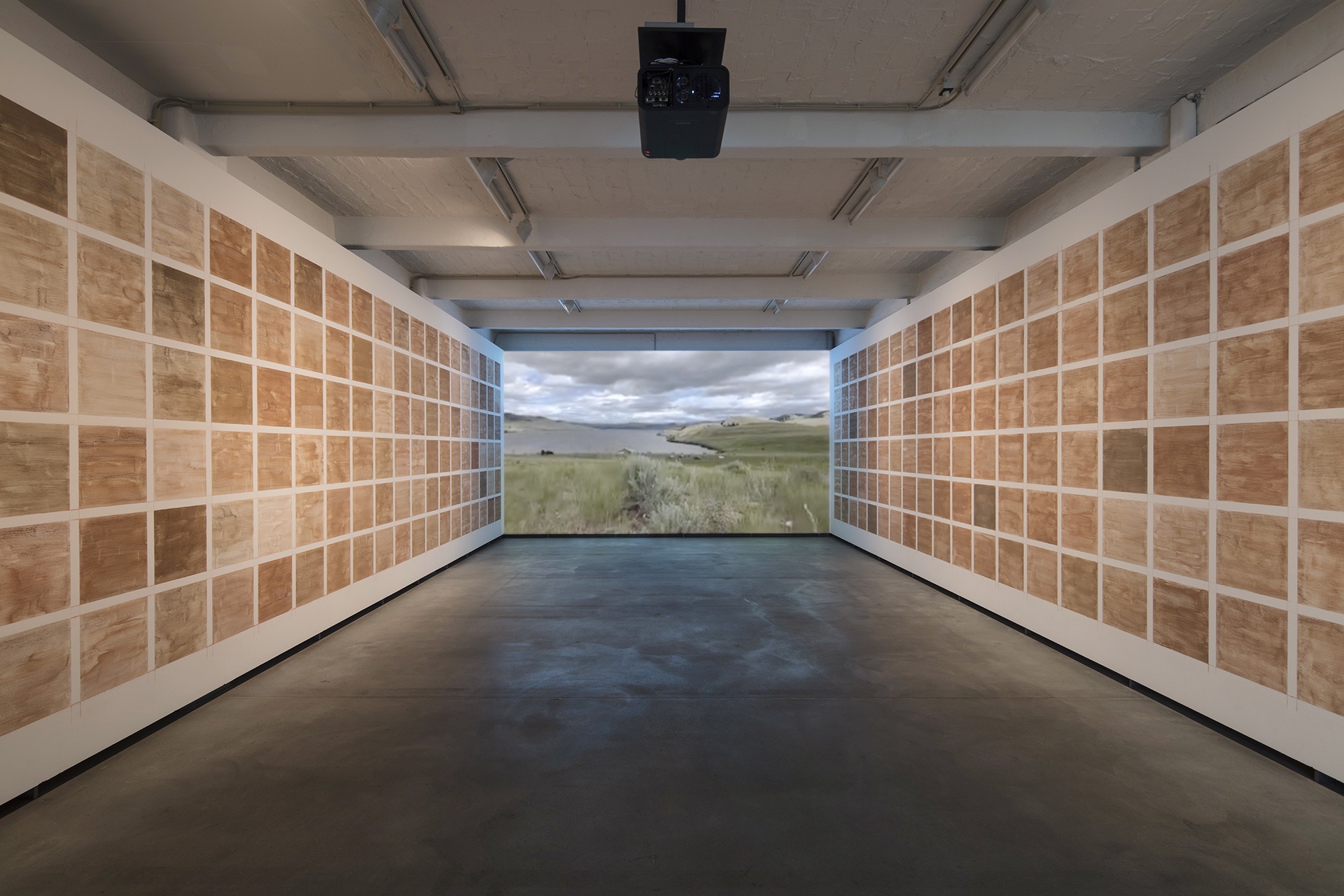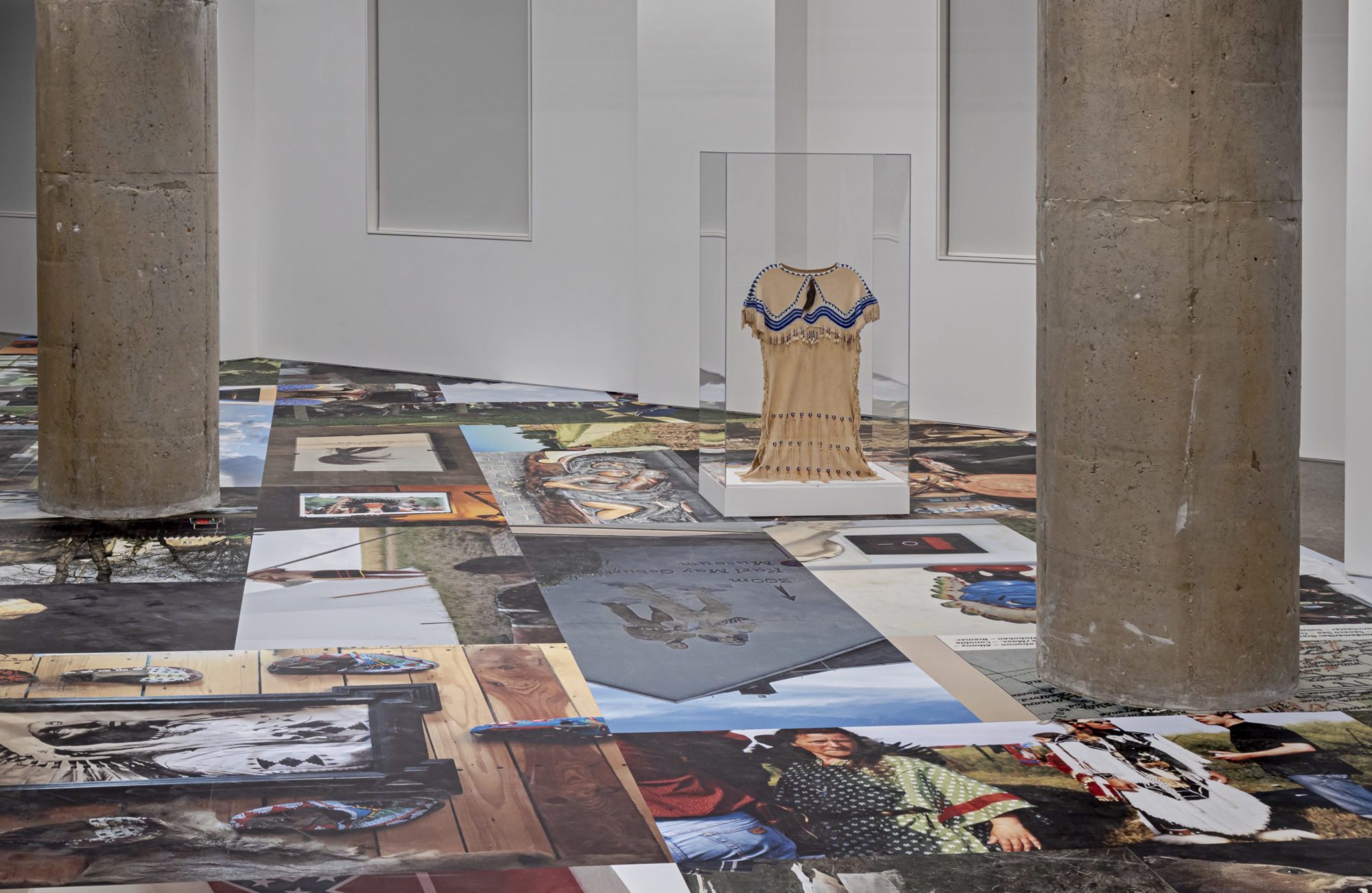Inaudibility: Krista Belle Stewart’s Sonic Repatriation of Knowledge
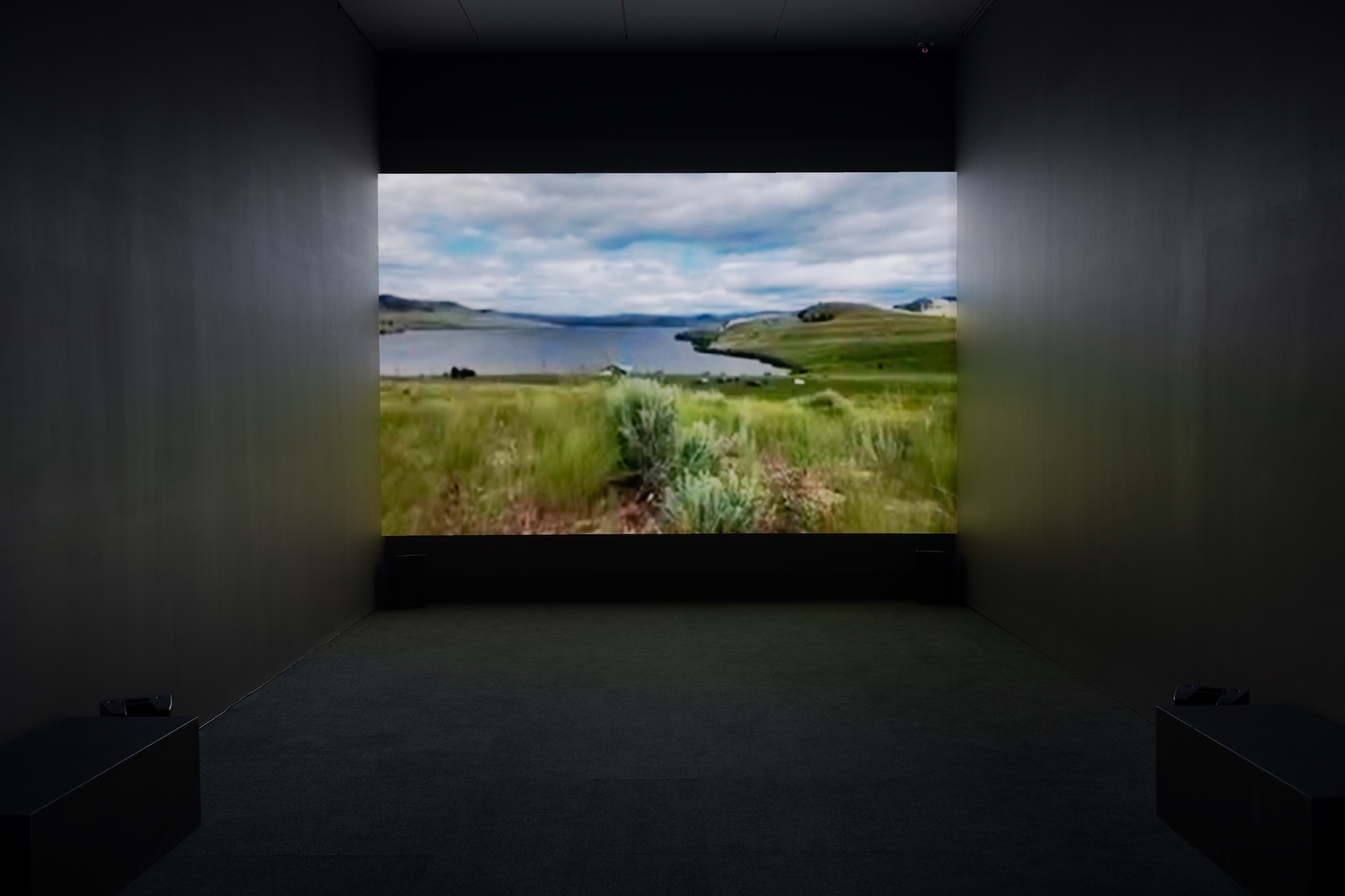
Krista Belle Stewart, Potato Gardens Band (Spaxomin version), video installation, 2019, Master’s thesis exhibition curated by Mathilde Walker-Billaud [photo: Chris Kendall; courtesy of Mathilde Walker-Billaud and CCS Bard, Annandale-on-Hudson, NY]
Share:
March 12, 2020
Email note from the museum curator
Subject: File Krista Belle
Hi there, Could you please upload Krista Belle´s file again? The file available on Dropbox is not correct, the image is blurred and the sound has really bad quality.
***
June 3, 2020
Email note from the museum head of production
Subject: Files for exhibition
Krista Belle Stewart: 16:9. The video is an excerpt 10.00 min. Very blocky quality and very low audio level. Is it the correct file? If so, the file have to be edited for the sound to be audible.1
Krista Belle Stewart, Potato Gardens Band (Spaxomin Version), 2018, screenshot taken from video of performance at 221A Pollyanna 圖書館 on June 30, 2018, video, 23 minutes [courtesy of the artist]
Watching Krista Belle Stewart’s video from the installation Potato Gardens Band (Spaxomin Version) for the first time, without any information about its context or production, is disconcerting. I understood why the curator and the technician responsible for the work’s installation would be concerned about the quality of the file. Shot from the top of a hill above Spaxomin (or Douglas Lake, in British Columbia, Canada), the 23-minute film consists of a series of poor and unstable images of a Pacific Northwest lakescape—a partial view of the Syilx (Okanagan) Nation’s territory, featuring a house and a few cars surrounded by grass and water. This blurry panorama is accompanied by an audio track consisting of wind sounds, machine beeps, and distant voices.
This video captures the live recording of a performance the artist enacted on her family’s land in spring 2018. It was the third iteration of Potato Gardens Band (2014–), a series of installations and performances based upon ethnographic recordings of the artist’s great grandmother, Terese Kaimetko, singing in Syilx. The artist—who was invited to be part of the live program sum of the parts, curated by Jenn Jackson and presented in 2018—brought her ancestor’s songs back to the site where they were originally produced. She played them for an intimate group of family members, many of whom had never before heard the recordings. The sonic reunion was broadcast live from Spaxomin to an audience at 221A Pollyanna 圖書館 Library in Vancouver, a few hundred miles away. A bucket of Syilx soil was placed atop a table at the center of the room. Above it, a monitor retransmitted a mobile phone recording of the performance, shot from the hilltop above Spaxomin—the closest spot from which livestreaming was permitted. Because of reception issues, the image and sound were imperfectly captured, and were relayed on an intermittent basis. Stewart’s family members were permitted access to a clear transmission of the original recordings, but viewers of the screening in Vancouver received a noisy and discontinuous version of the experience.2 The video’s spectators were placed in the uncomfortable, if not impossible, position of listening to the recording from afar.
The distance that Stewart carved out between her great grandmother’s voice and her audience was both geographical and technological, as the recording’s transmission was filtered through multiple media. First, the artist amplified it through two PA speakers, installed before and behind her brother’s truck, parked near the lake house. Given the distance separating the event and the camera documenting it, Stewart placed a microphone halfway between the two and used walkie-talkies to retransmit the sound from the bottom of the hill to the top. Moreover, the recording she played was not the original from the archives—produced by ethnographer James Teit ca. 1915—but a copy of a copy. It was the digitized version of a cassette tape transferred from wax cylinder by the staff at the Canadian Museum of History in Gatineau, where the ethnographic recording is now kept.3 What we hear is Kaimetko’s voice distorted by the cracks in the wax cylinder; the introductory comments of the conservator, who vocally introduced each song as he made the tape transfer; and the beeping of the walkie-talkie radio.
Krista Belle Stewart, Potato Gardens Band (Spaxomin version), video installation, 2020, exhibition curated by Mathilde Walker-Billaud [photo: Jean-Baptiste Beranger; courtesy of Mathilde Walker-Billaud and Bonniers Konsthall Museum]
Krista Belle Stewart, Potato Gardens Band (Spaxomin version), video installation, 2020, exhibition curated by Mathilde Walker-Billaud [photo: Jean-Baptiste Beranger; courtesy of Mathilde Walker-Billaud and Bonniers Konsthall Museum]
The performance took place on a windy day. Microphones placed on the prairie captured the wind battering the equipment. At times, Kaimetko’s voice loudly pierced the acoustic environment of the gallery, taking the form of a spectral presence. This method of transmitting Kaimetko’s performance activated the voice as a living and affective artifact, an object that aspired to be a subject.4 The recording resonated like a repressed memory, coming in and out of a stream of consciousness.
The quasi-inaudibility of Kaimetko’s song is not the result of an accident or an amateur operation, but an aesthetic and epistemological gesture, a “deliberate enactment,” as the artist puts it. As a multidisciplinary practitioner, Stewart has been working with various forms of archives, including photography, audio recording, film, performance, and soil, which document the experience and practices of First Nations, Métis, and Inuit people living in North America, with a particular interest in the Syilx Nation, of which her kin are members. In her installations (Sim – real / very; Seraphine. Seraphine; Truth to Material) she investigates the construction of truth within the materiality of archives produced by White settlers and Europeans. Stewart often addresses what lawyer Jane E. Anderson refers to as the “anxieties of authorship in colonial archives,” which occurs when people of Indigenous descent realize that institutions continue to frame Aboriginal communities within a Euro-American–centric discourse, while offering those communities no control over it. In Potato Gardens Band, Stewart addresses this issue of authorship by obstructing the listening experience. By withdrawing an archival object, which is classified under the name of ethnographer James Teit, in a public museum dedicated to Canadian history; and by making it inaccessible to the gallery public, she claims this recording as a family artifact. Her action sheds light on the colonial legacies embedded in the production, organization, and framing of archival materials, and it reveals the archives as a “White space.”5 Stewart’s apparatus disrupts the authority of the institution and the narratives of power it sustains.6 Inaudibility is therefore a strategy to make epistemic violence palpable and legible.
In recent years, several scholars, curators, and artists engaged with sound and race have highlighted the political and aesthetic significance of inaudibility.7 In the first chapter of Hungry Listening: Resonant Theory for Indigenous Sound Studies, scholar and curator Dylan Robinson introduces the concept of “tin ear” to describe White settlers’ historical incapacity and unwillingness to hear the cosmological depth of Aboriginal songs. Tin ear or, more frankly, this normative and Eurocentric listening practice based upon hierarchy and discrimination, is something cultural historian and curator Anette Hoffman recently encountered in an extreme form during her research on 1931 wax cylinder recordings of Namibians by Hans Lichtenecker, a German amateur scientist and anthropologist. She realized that the voices had been archived for more than 70 years without any translation or contextualization.8 The Namibian speakers were silenced within the archives, reduced to nonverbal glossolalic samples—to “wild sounds.”9 Between 2008 and 2016, media pioneer Susan Hiller exposed the mechanism of control exerted over the voices of non-Western peoples. Her films The Last Silent Movie (2008) and Lost and Found (2016), which have circulated in Europe and North America, serve as a platform for voices that have been forgotten in Western ethnographic archives. In these two sound-driven collages, Hiller accumulates sources and recuts fragments in a way that magnifies anthropologists’ and cataloguers’ obsession toward the archiving of rare languages which they mostly consider as distant and abstract objects of study.10 Hiller makes visible the continuing asymmetrical and colonial relations between the recorded and the recorder, the voices and the listeners.
The apparatus Hiller conceived for non-Western voices is addressed mainly to Western gallery visitors, making the archival databases they use appear uncanny, ambivalent, and multilayered to their eyes and ears. Potato Gardens Band thus operates inside and outside the Western system of listening. Stewart refuses to give gallery visitors complete access to Kaimetko’s voice, thereby blocking any form of symbolic or material appropriation. The extractive practices that Stewart counters in her work can be examined through the crucial concept of “hungry listening,” which Dylan Robinson introduces and explores in his research on Indigenous sound practices.11 The term hungry refers to the Halq’eméylem word shxwelítemelh—“White settler” or, more literally, “starving person.” The hunger refers not only to the state of starvation of the European traders who arrived on the Xwélmexw territory in the mid-19th century but to their greed for gold and their extractive mindset.12 Like the European settlers whose attention is directed toward profit, the ear of the hungry listener is governed by consumption and accumulation. In Potato Gardens Band, Stewart makes the Euro-American sonic sensibility—directed toward archival, anthropological, or aesthetic extraction—brutally palpable but also unacceptable. Inaudible, Kaimetko’s Aboriginal voice becomes non-consumable, “indigestible,”13 and Stewart’s work suggests that the place of this recording lies outside a consumerist Euro–North American framing, outside the anthropological–aesthetic object system.14 The issue is not only one of cultural appropriation or ethics, but of epistemology and ontology—concerned with knowledge production and transmission.
Krista Belle Stewart, Potato Gardens Band (Spaxomin Version), 2018, screenshot taken from video of the artist with family members listening to digitized wax cylinder recordings on June 30, 2018, performance, video, 23 minutes [courtesy of the artist]
Krista Belle Stewart, Potato Gardens Band, 2019, video, 23 minutes, Spaxomin pigment, installation view, Kunstlerhaus Bethanien, Berlin, DE [photo: David Brandt; courtesy of the artist]
Krista Belle Stewart, Truth to Material, 2020. The Gift, 2019, Nez Perce regalia style dress and belt made for the artist by Johannes in 2007, gifted to the artist in 2019, deer hide, deer tails, glass beads, seed beads, cowry shells, sinew, acrylic paint. Accession no. 20190802.1. Die Angst, 2006, 2007, 2019 laminated vinyl installation view. MOCA Toronto, CA [photo: Toni Hafkenscheid; courtesy of the artist]
Stewart’s work is an invitation to redress normative listening attention and perception. Her gesture of obstruction, which goes beyond censorship or sabotage, generates an alternative mode of transmission, developed from an Indigenous perspective and epistemology. Multidirectional and acousmatic, embedded in a soundscape of technology and wind, Kaimetko’s voice merges with its original site of production and the archiving machinery. The body, land, and technology are unified in one audiovisual event, becoming one material flow, one physical sound wave. Gallery visitors’ listening experiences mimic the recording operation—the machine “recorded nothing [more] than vibrations,”15 capturing animate and nonanimate sounds without any distinction or hierarchy.16 Listeners are left wondering how to translate the audio track and must work hard to identify what makes the moving image vibrate.17 In this materialistic soundscape,18 where the Western dichotomies between signal and noise, music and ambient sound, culture and nature are abolished, the voice returns. With her sonic gesture, Stewart enacts the multilayered and multisensory significance of her Aboriginal ancestor’s voice, which poses as knowledge.19 She reveals the recording’s force and significance as productive of history and law. In this deliberate enactment, in this collective and performative activation of sovereignty, the artist sonically repatriates the audio archive and the world it encapsulates. The spectators bear witness to the reunification of Kaimetko’s voice with her land and territory.
The anecdote I began this article with was not anodyne. Incomprehensibility and impenetrability are crucial to grasp the depth of Kaimetko’s Aboriginal voice and perceive Stewart’s approach to her family archive. Unsettling the modality of listening is part of a larger artistic project that redirects attention toward the agency of materials and the repressed knowledge it has bound. When I presented Stewart’s Potato Gardens Band for the first time—as part of the 2019 exhibition this is the no thing that we are at CCS Bard20 —Stewart and I discussed the reactions of some visitors, who dismissed the video as amateur work or a malfunctioning installation. I remember Stewart’s answer to this rejection. She was seated quietly in the screening room, sensing the vibratory presence of her ancestor and land. She looked at me, and with both pride and modesty, said: “It means it’s not for them, and that’s okay.”
Mathilde Walker-Billaud is a curator and cultural producer based in New York City. She held positions as assistant editor at the Centre National de la Danse, program director at the Cultural Services of the French embassy in New York, program officer at Villa Gillet NYC festival “Walls and Bridges,” workshop programmer at UnionDocs, and creative manager at company nora chipaumire. A recent MA graduate from the Center for Curatorial Studies at Bard College, she organized and hosted lectures, screenings, and performances at various institutions, including CCS Bard, Colgate University, UnionDocs, Triangle Arts Association, Anthology Film Archives, and the Metrograph. Her more recent project is the BKH Curator Award 2020 exhibition The World Is Gone, I Must Carry You at Bonniers Konsthall, Stockholm. Her writing has appeared in BOMB Magazine, ART PAPERS, and the 2020 Isola Cinema International Film Festival. She can be heard in the podcast Benjamen Walker’s Theory of Everything.
References
| ↑1 | Private emails to the author. |
|---|---|
| ↑2 | Jenn Jackson. Art and the Archive: The Status of the Document, A thesis submitted for the degree of Master of Arts, art history and theory (Vancouver: University of British Columbia, 2018), 73. |
| ↑3 | Stewart’s cassette is likely a copy of an archival recording made by museum staff in the 1980’s or 1990’s. This information is based on my conversation with the artist, and my email exchanges with Judith Klassen and Jonathan Wise from the Canadian Museum of History and Wendy Wickwire from the Department of History at the University of Victoria. |
| ↑4 | Brandon Labelle. Lexicon of the Mouth: Poetics and Politics of Voice and the Oral Imaginary (London: Bloomsbury, 2014), 1. |
| ↑5 | White public spaces are defined here as academic structures in North America that reinforce and reproduce Whiteness. See Zoe Todd, “Indigenizing the Anthropocene.” In Heather Davis and Etienne Turpin, eds. Art in the Anthropocene: Encounters Among Aesthetics, Politics, Environment and Epistemology (London: Open Humanities Press, 2015), 247. |
| ↑6 | Jane Anderson, “Anxieties of Authorship in the Colonial Archive.” In Media Authorship, Taylor and Francis eds. (2013), 232. Jane Anderson looks at archives as a colonial process enacted by administrators, bureaucrats, and anthropologists to classify and control peoples, and to support European centrism and colonial dispossession of lands. |
| ↑7 | Such scholars as Ashon Crawley, Roshanak Kheshti, Anette Hoffmann, Pooja Rangan, Dylan Robinson, and Gustavus Stadler; and curators Nida Ghouse, Candice Hopkins, and Nuria Querol have recently worked toward decoding colonial and normative listening practices. For more details about scholarship on listening and race, see Dylan Robinson, Hungry Listening: Resonant Theory for Indigenous Sound Studies (Minneapolis: Minnesota University Press, 2020), 722 (Kindle location). |
| ↑8 | Anette Hoffmann, ed., What We See. Reconsidering an Anthropometrical Collection from Southern Africa: Images, Voices and Versioning, (Basler Afrika Bibliographien, Basel, Switzerland, 2009). Catalogue of exhibition presented at the Slave Lodge, IZIKO Museums, Cape Town, South Africa, 2009. |
| ↑9 | Richard Cullen Rath, How Early America Sounded (NY: Cornell University Press, 2003), 147–148; 152. |
| ↑10 | Hiller said that “we [Westerners] value creating archives more than [we value] sustaining peoples.” Quote from a personal email to Jörg Heiser, retold by the curator in an interview with the artist in: Susan Hiller, exhibition catalogue (London: Tate Britain, 2011), 33. |
| ↑11 | Dylan Robinson, Hungry Listening: Resonant Theory for Indigenous Sound Studies (Minneapolis: Minnesota University Press, 2020), 99 (Kindle location). I first heard about Robinson’s concept in Candice Hopkins’ “Sounding the Margins: A Choir of Minor Voices” talk given on June 14, 2016, at Small Projects, Grønnegata 23, Tromsø. Available via vimeo.com |
| ↑12 | Dylan Robinson, Hungry Listening: Resonant Theory for Indigenous Sound Studies (Minneapolis: Minnesota University Press, 2020), 709 (Kindle location). |
| ↑13 | Ibid., 1269 (Kindle location). |
| ↑14 | Term used by James Clifford in “Histories of the Tribal and the Modern.” In The Predicament of Culture. Twentieth-Century Ethnography, Literature and Art. (Harvard University Press: Cambridge, Massachusetts, 1988), 189-214. |
| ↑15 | Friedrich A. Kittler, Gramophone, Film, Typewriter, trans. Geoffrey Winthrop-Young and Michael Wutz (Stanford, CA: Stanford University Press, 1999), 24. |
| ↑16 | Christoph Cox, “A Brief History of Sound Art,” a lecture at the Barnes Foundation, Philadelphia, on January 18, 2017. Available via sonicfield.org |
| ↑17 | Jenn Jackson, Art and the Archive: The Status of the Document, a thesis submitted for the degree of Master of Arts, art history and theory (Vancouver: University of British Columbia, 2018), 74. |
| ↑18 | For more information about this materialist conception of listening, please consult Christoph Cox, “Listening as Agon in the Society of Control,” in What Now? The Politics of Listening, eds. Anne Barlow, Lindsey Berfond, and Kristen Chappa (London: Black Dog, 2016). |
| ↑19 | Dylan Robinson, Hungry Listening: Resonant Theory for Indigenous Sound Studies (Minneapolis: Minnesota University Press, 2020), 202 (Kindle location). |
| ↑20 | The author would like to thank the artist for her generosity and trust, as well as Candice Hopkins and Jeannine Tang for their guidance in this research. |
